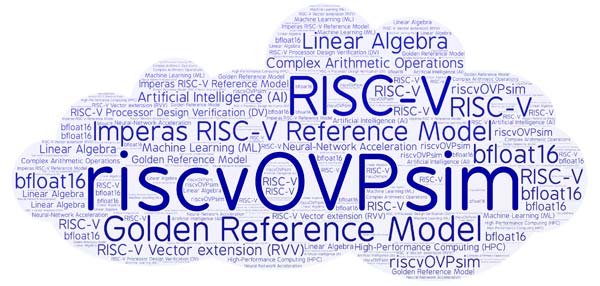 Imperas Software Ltd., the leader in virtual platforms and high-performance software simulation, today announced that the free riscvOVPsim™ RISC-V reference model and simulator, which has been widely adopted across the RISC-V ecosystem, has been updated and extended for RISC-V vector instructions and now supports coverage driven verification analysis. The base version of riscvOVPsim is available for free from a new GitHub site (github.com/riscv-ovpsim), with an enhanced version including an extensive RISC-V vector test suite also freely available for commercial use from Open Virtual Platforms (OVPworld.org/riscv-ovpsim).
Imperas Software Ltd., the leader in virtual platforms and high-performance software simulation, today announced that the free riscvOVPsim™ RISC-V reference model and simulator, which has been widely adopted across the RISC-V ecosystem, has been updated and extended for RISC-V vector instructions and now supports coverage driven verification analysis. The base version of riscvOVPsim is available for free from a new GitHub site (github.com/riscv-ovpsim), with an enhanced version including an extensive RISC-V vector test suite also freely available for commercial use from Open Virtual Platforms (OVPworld.org/riscv-ovpsim).
The upcoming ratification of the RISC-V Vector instruction extension offers system designers broad flexibility to configure vector engines to support complex arithmetic operations required for applications involving linear algebra, such HPC (High-Performance Computing), AI (Artificial Intelligence) and ML (Machine Learning) applications. With these latest enhancements to riscvOVPsim, software developers and system architects can start to explore RISC-V based solutions, while Design Verification (DV) Engineers can configure the models for test benches and test frameworks with coverage analysis.
The open standard ISA (Instruction Set Architecture) of RISC-V offers processor designers many options and configuration possibilities and across the RISC-V ecosystem the efficient description of these parameters is becoming more important as part of the verification, compliance, tools and software support for RISC-V. The riscvOVPsim simulator includes an envelope model that supports all the RISC-V ratified specification options, which can be easily configured to match targeted processor features as a key step in setting up a verification test bench. riscvOVPsim has also been updated with coverage features that easily and efficiently support instruction functional coverage-based verification flows. Since Imperas first launched riscvOVPsim to support the RISC-V International compliance working group in 2018, it has become widely adopted by both open source and commercial processor development teams looking for a dependable RISC-V reference model that can be easily configured and is the key reference within their compliance, directed and random test generation environments and frameworks.
The Imperas support for the RISC-V vector instruction extension also includes a new architectural validation test suite which features detailed instruction tests for a base vector engine configured as RV32GCV with elen:32, vlen:256, slen:256. The vector suite is built by the Imperas directed test generator and includes over 3 million instructions in 5-7,000 test files (depending on suite configuration), with full source, assertions, and reference signatures. (More details here: https://github.com/riscv-ovpsim/imperas-riscv-tests/tree/main/riscv-test-suite.) The tests currently achieve over 85% instruction functional coverage which will approach 100% when the vector instruction extensions are ratified by RISC-V International. The test suite can be generated for any of the recent published draft specifications (including 0.8, 0.9, 1.0draft) and compliant vector engine configurations including enhanced options such as use of BFloat16 for floating point optimized for accelerating machine learning and near-sensor computing applications.
The new enhanced simulator and new test suites are freely available with many processor, behavioral, and virtual platform models, with various SystemVerilog examples and test benches for Hardware Design Verification and other community resources from Open Virtual Platforms at OVPworld.org/riscv/.
“The RISC-V International working groups have made considerable progress in building a robust ecosystem of tools to help developers more easily test and verify RISC-V solutions,” said Mark Himelstein, CTO of RISC-V International. “We’re pleased to see Imperas’ contributions for this reference model and early RV32I test suite, which really underscore the importance of compliance suite adoption for the whole community.”
“The AndesCore NX27V processor was the first licensable RISC-V core to support the new RISC-V vector instruction extension,” said Charlie Hong-Men Su, CTO and Executive Vice President at Andes Technology Corp. “In addition to Andes’ own cycle accurate reference model, Andes has certified the Imperas RISC-V Vectors reference model for use with lead customers and partners with this exciting and powerful new era of compute technology.”
“An architectural validation suite is not a complete verification test plan for a RISC-V processor but shares many similar attributes and its adoption is always useful at any stage of a project,” said Bill McSpadden, Principal VLSI Verification Engineer at Seagate Technology, and co-chair of the RISC-V International’s Technical Committee task group for compliance. “Any test plan requires 4 items – a device to test, some tests, a reference to compare against and a test plan. An easy-to-configure reference model that supports coverage driven analysis, like Imperas’ riscvOVPsim, is central to any test plan.”
“RISC-V Vectors Extensions are not just a technical specification, they represent the framework to develop the next generation of compute engines for key markets with advanced requirements,” said Simon Davidmann, CEO at Imperas Software Ltd. “The dynamic multi-state operation of a vector processor is not just complex to design but is pushing the boundary of state-of-the-art design verification methodologies. Imperas simulation technology and reference models are now at the center of the most advanced design verification teams adopting RISC-V.”
Availability
The free riscvOVPsim is now available on GitHub at https://github.com/riscv-ovpsim.
The free enhanced riscvOVPsim including the vector test suite as highlighted above is now available on OVPworld at: https://www.ovpworld.org/riscv-ovpsim.


